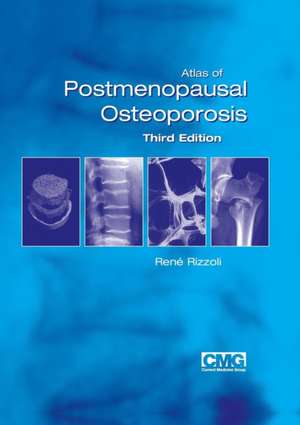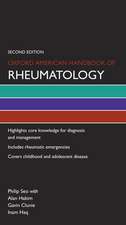Atlas of Postmenopausal Osteoporosis: Third Edition
Editat de Rene Rizzolien Limba Engleză Paperback – 6 noi 2011
Preț: 365.46 lei
Preț vechi: 384.70 lei
-5% Nou
Puncte Express: 548
Preț estimativ în valută:
69.94€ • 75.94$ • 58.75£
69.94€ • 75.94$ • 58.75£
Carte tipărită la comandă
Livrare economică 22 aprilie-06 mai
Preluare comenzi: 021 569.72.76
Specificații
ISBN-13: 9781858734439
ISBN-10: 1858734436
Pagini: 132
Ilustrații: IX, 118 p.
Dimensiuni: 210 x 297 x 7 mm
Greutate: 0.34 kg
Ediția:3rd ed. 2010
Editura: Springer
Colecția Springer Healthcare
Locul publicării:Tarporley, United Kingdom
ISBN-10: 1858734436
Pagini: 132
Ilustrații: IX, 118 p.
Dimensiuni: 210 x 297 x 7 mm
Greutate: 0.34 kg
Ediția:3rd ed. 2010
Editura: Springer
Colecția Springer Healthcare
Locul publicării:Tarporley, United Kingdom
Public țintă
Professional/practitionerDescriere
René Rizzoli Menopause is the time in a woman’s life when reproductive capacity ends. Ovaries decrease their activity and the production of sex hormones ceases. This period may be associated with a large variety of symptoms affecting the cardiovascular and urogenital systems, as well as skin, hair and bone. Bone capital is accumulated by the end of the second decade and remains more or less constant up to the time of menopause. Sex hormone deficiency leads to accelerated bone turnover, a negative balance and microarchitectural deterioration, which compromises bone strength, thereby increasing bone fragility and, thus, fracture risk. By the age of 80, it is estimated that 50% of trab- ular bone will have been lost. Natural menopause occurs between the ages of 45 and 54 years all over the world. This age does not appear to have changed significantly over the centuries. In contrast, since the middle of the 19th century, life expectancy, particularly in women, has increased considerably, with most women living to the age of 80 years or more in many regions of the world. This means that at the age of 50 years, a woman will live for more than 30 years without bone protection by sex hormones. This r- resents more than one-third of a woman’s life. At the age of 50 years, the lifetime risk to experience a fracture is about 50% (ie, one out of two women will have a fracture during this period).
Cuprins
Pathophysiology of postmenopausal osteoporosis.- Epidemiology and diagnosis of postmenopausal osteoporosis.- Bone quality and strength.- Prevention and treatment of postmenopausal osteoporosis.- Conclusion.
Notă biografică
René Rizzoli is an internist and endocrinologist, with a subspecialty focus on metabolic bone diseases, osteoporosis and disorders of mineral metabolism. He is Professor of Medicine at the University Hospital of Geneva, Geneva, Switzerland and Head of the Division of Bone Diseases of the Department of Rehabilitation and Geriatrics. He is also chairman of this department. The Division of Bone Diseases is a World Health Organization (WHO) collaborating center for osteoporosis prevention. Professor Rizzoli is a member of the Executive Committee of the International Osteoporosis Foundation (IOF), and is the chairman of the Scientific Advisory Board of the European Society for Clinical and Economical Aspects of Osteoporosis and Osteoarthritis. He has also been chairman of the Committee of Scientific Advisors of the IOF, a position which he held for two mandates, and is a former president of the Swiss Association against Osteoporosis. He has chaired the scientific program committee of three consecutive IOF World Congresses on Osteoporosis. Professor Rizzoli is the Editor of the journal Bone and Associate Editor of Osteoporosis International, and has authored more than 550 articles and book chapters. He is involved in both basic and clinical research projects investigating hormone action, regulation of bone growth, mineral homeostasis, pathophysiology of osteoporosis and the role of nutrition, calcium, bisphosphonates, selective estrogen modulators (SERMs) and strontium ranelate in the prevention and treatment of osteoporosis.










